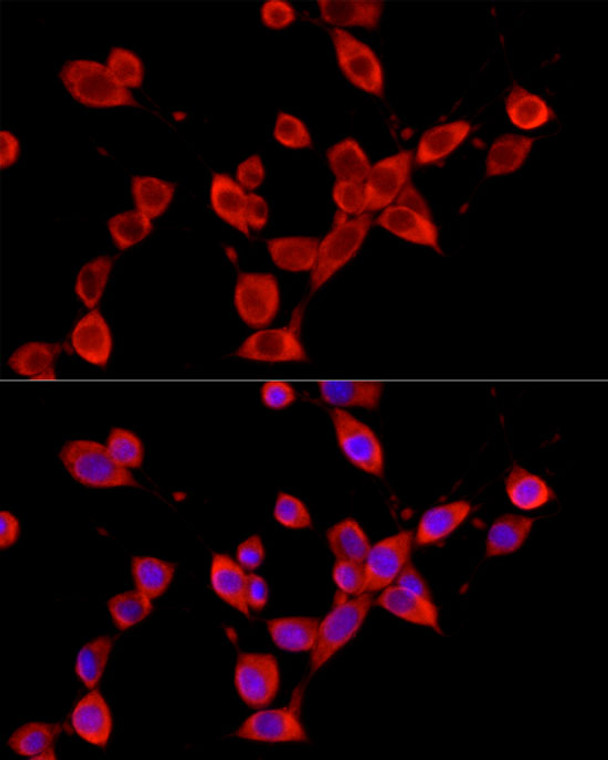| Host: |
Rabbit |
| Applications: |
WB/IHC/IF/IP |
| Reactivity: |
Human/Mouse/Rat |
| Note: |
STRICTLY FOR FURTHER SCIENTIFIC RESEARCH USE ONLY (RUO). MUST NOT TO BE USED IN DIAGNOSTIC OR THERAPEUTIC APPLICATIONS. |
| Short Description: |
Rabbit polyclonal antibody anti-YTHDF3 (1-275) is suitable for use in Western Blot, Immunohistochemistry, Immunofluorescence and Immunoprecipitation research applications. |
| Clonality: |
Polyclonal |
| Conjugation: |
Unconjugated |
| Isotype: |
IgG |
| Formulation: |
PBS with 0.02% Sodium Azide, 50% Glycerol, pH7.3. |
| Purification: |
Affinity purification |
| Dilution Range: |
WB 1:500-1:1000IHC-P 1:100-1:500IF/ICC 1:50-1:200IP 1:500-1:1000 |
| Storage Instruction: |
Store at-20°C for up to 1 year from the date of receipt, and avoid repeat freeze-thaw cycles. |
| Gene Symbol: |
YTHDF3 |
| Gene ID: |
253943 |
| Uniprot ID: |
YTHD3_HUMAN |
| Immunogen Region: |
1-275 |
| Immunogen: |
Recombinant fusion protein containing a sequence corresponding to amino acids 1-275 of human YTHDF3 (NP_689971.4). |
| Immunogen Sequence: |
MSATSVDQRPKGQGNKVSVQ NGSIHQKDAVNDDDFEPYLS SQTNQSNSYPPMSDPYMPSY YAPSIGFPYSLGEAAWSTAG DQPMPYLTTYGQMSNGEHHY IPDGVFSQPGALGNTPPFLG QHGFNFFPGNADFSTWGTSG SQGQSTQSSAYSSSYGYPPS SLGRAITDGQAGFGNDTLSK VPGISSIEQGMTGLKIGGDL TAAVTKTVGTALSSSGMTSI ATNSVPPVSSAAPKPTSWA |
| Post Translational Modifications | (Microbial infection) Proteolytically cleaved by HIV-1 protease when incorporated into HIV-1 particles in a nucleocapsid-dependent-manner. Cleavage by HIV-1 protease probably ensures optimal infectivity of the mature virion. |
| Function | Specifically recognizes and binds N6-methyladenosine (m6A)-containing RNAs, and regulates their stability. M6A is a modification present at internal sites of mRNAs and some non-coding RNAs and plays a role in mRNA stability and processing. Acts as a regulator of mRNA stability by promoting degradation of m6A-containing mRNAs via interaction with the CCR4-NOT complex or PAN3. The YTHDF paralogs (YTHDF1, YTHDF2 and YTHDF3) share m6A-containing mRNAs targets and act redundantly to mediate mRNA degradation and cellular differentiation. Acts as a negative regulator of type I interferon response by down-regulating interferon-stimulated genes (ISGs) expression: acts by binding to FOXO3 mRNAs. Binds to FOXO3 mRNAs independently of METTL3-mediated m6A modification. Can also act as a regulator of mRNA stability in cooperation with YTHDF2 by binding to m6A-containing mRNA and promoting their degradation. Recognizes and binds m6A-containing circular RNAs (circRNAs).circRNAs are generated through back-splicing of pre-mRNAs, a non-canonical splicing process promoted by dsRNA structures across circularizing exons. Promotes formation of phase-separated membraneless compartments, such as P-bodies or stress granules, by undergoing liquid-liquid phase separation upon binding to mRNAs containing multiple m6A-modified residues: polymethylated mRNAs act as a multivalent scaffold for the binding of YTHDF proteins, juxtaposing their disordered regions and thereby leading to phase separation. The resulting mRNA-YTHDF complexes then partition into different endogenous phase-separated membraneless compartments, such as P-bodies, stress granules or neuronal RNA granules. May also recognize and bind N1-methyladenosine (m1A)-containing mRNAs: inhibits trophoblast invasion by binding to m1A-methylated transcripts of IGF1R, promoting their degradation. Has some antiviral activity against HIV-1 virus: incorporated into HIV-1 particles in a nucleocapsid-dependent manner and reduces viral infectivity in the next cycle of infection. May interfere with this early step of the viral life cycle by binding to N6-methyladenosine (m6A) modified sites on the HIV-1 RNA genome. |
| Protein Name | Yth Domain-Containing Family Protein 3Df3 |
| Cellular Localisation | CytoplasmCytosolP-BodyStress Granule |
| Alternative Antibody Names | Anti-Yth Domain-Containing Family Protein 3 antibodyAnti-Df3 antibodyAnti-YTHDF3 antibody |
Information sourced from Uniprot.org
12 months for antibodies. 6 months for ELISA Kits. Please see website T&Cs for further guidance













